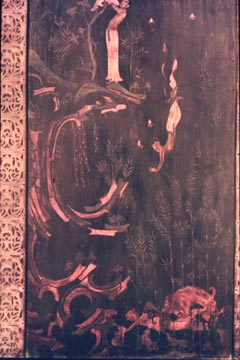| architecture |
| calligraphy |
| ceramics |
| clothing |
| comics |
| gardens |
| lacquerwork |
| literature |
| movies |
| music |
| painting |
| poetry |
| sculpture |
| tea ceremony |
| television |
| theatre |
| weaponry |
| thematic routes |
| timeline |
| the site |
context: painting > early painting > buddhist painting
Tamamushi shrine

|
Bodhisattva's Sacrifice, from the Tamamushi shrine |
This portable shrine from the mid-seventh Century is extraordinary on a few levels. It's the first known Japanese work with a narrative content - the Boddhisattva is up top, taking his clothes off for the dive to become the tiger's meal at the bottom. He appears three times in the same scene, a pretty sophisticated use of narrative. I note that the sequence is top to bottom, whereas the usual for the centuries to come would of course be right to left - but there are occasional top-down examples.
Secondly, I have read recently that scientific examination of this artwork, painted on wooden panels, shows them not to be the lacquer that had been believed but a kind of oil paint - this is, as far as I know, the only instance of Japanese oil painting before Europeans brought the technique a thousand years later. I've not seen any explanation of this, or of why it didn't catch on.
